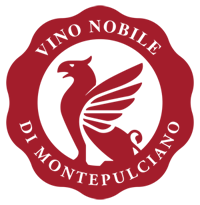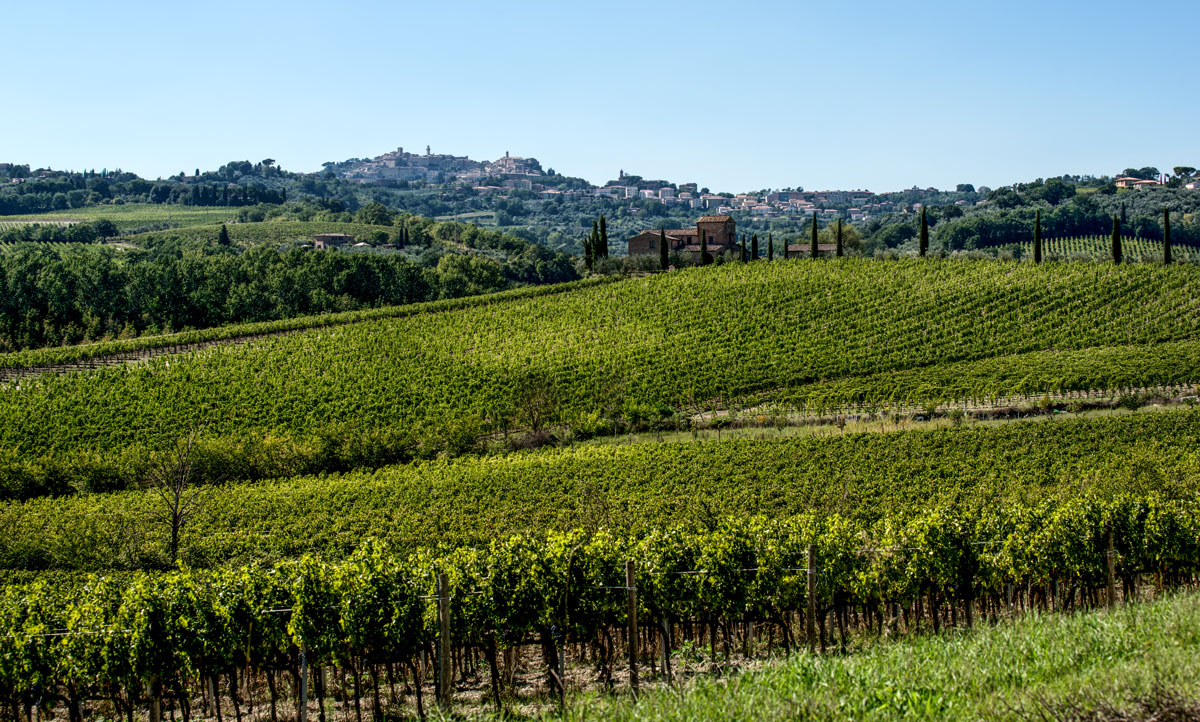Scroll right or use the arrows to discover all the disciplinary
-
DENOMINAZIONE DI ORIGINE CONTROLLATA E GARANTITA
VINO NOBILE DI MONTEPULCIANO
THE LAW: The first production regulations were drawn up on July 12 1966. In 1980 Vino Nobile di Montepulciano was granted the Denominazione di Origine Controllata e Garantita, and was the first wine to be released with the top classification recognised by Italian legislation. The most recent modifications were approved by decree on November 9th 2010.
PRODUCTION ZONE: The territory of the commune of Montepulciano excluding the area of the Valdichiana, and limited to vineyards situated between 250 and 600 metres above sea level. 
THE GRAPES: Sangiovese, minimum 70% may be joined up to 30% by other varieties authorized for the Tuscany Region. 
YIELDS: The maximum yield of grapes per hectare is 8 tons. 
AGEING: Vinification and compulsory ageing must take place within the territory of the commune of Montepulciano. Wine with the appellation Vino Nobile di Montepulciano DOCG must undergo an ageing period of at least two years, starting from January 1st following the harvest. Within this period producers may choose from the following options: 1- 24 months of maturation in wood. 2- 18 months minimum maturation in wood and the remaining months in other ageing vessels. 3- 12 months minimum in wood and six months minimum in bottle and the remaining months in other ageing vessels. In the second and third cases, the beginning of wood ageing must not be after April 30 of the year following the harvest. 4- Wine with the appellation Vino Nobile di Montepulciano DOCG cannot be released before the end of the two years maturation prescribed by law, with the starting date being January 1st of the year following the grape harvest. BOTTLING: Bottling operations must take place within the vinification zone. Wine with the appellation Vino Nobile di Montepulciano DOCG which does not qualify as riserva may be bottled in the entire territory of the region of Tuscany by cellars which have been bottling Vino Nobile di Montepulciano DOCG for at least three years before the present production regulations came into effect.
BOTTLING: Bottling operations must take place within the vinification zone. Wine with the appellation Vino Nobile di Montepulciano DOCG which does not qualify as riserva may be bottled in the entire territory of the region of Tuscany by cellars which have been bottling Vino Nobile di Montepulciano DOCG for at least three years before the present production regulations came into effect.
RISERVA: Wine with the appellation Vino Nobile di Montepulciano DOCG deriving from grapes with a minimum natural alcoholic content by volume of 12.50% and subjected to an ageing period of at least 3 years of which six months must be in bottle, may have the added qualification riserva on the label, with the minimum time to be spent in wood as stipulated. 
CHARACTERISTICS: Minimum total alcoholic strength by volume: 12.50%, for the Riserva 13.00% Minimum total acidity: 4.5 g/l Minimum net dry extract: 23 g/l.
-
DENOMINAZIONE DI ORIGINE CONTROLLATA E GARANTITA
VINO NOBILE DI MONTEPULCIANO PIEVE
THE LAW:
The Vino Nobile di Montepulciano “Pieve” D.O.C.G. wine Production Regulations were provisionally published in the Official Journal on 21 November 2024.

PRODUCTION ZONE: The Vino Nobile di Montepulciano “Pieve” wine can only be produced inside the municipality of Montepulciano, but not in the Valdichiana area.
The “Pieve” wine must originate from vineyards that are at least 15 years old, located at an altitude between 250 and 600 meters above sea level, and managed directly by the wineries responsible for its bottling.
THE GRAPES: The wine can contain no less than 85% Sangiovese, whilst up to 15% of complementary varieties such as Canaiolo nero, Ciliegiolo nero, Mammolo nero, and Colorino nero may be used, (no more than 5% of Colorino nero is permitted).

YIELDS: 7000 kg of grapes per hectare, whilst the maximum production cannot exceed 2.5 kg of grapes per vine.

AGEING:
Starting on 1st January of the year following the grape harvest, the wine must be aged for at least three years. During this three-year period, the wines are first to be aged in wooden barrels for no less than 12 months and then in the bottle for no less than 12 months. The wine will then be tested chemically, physically, and for its organoleptic features only once the period of bottle ageing has been completed.

BOTTLING:
Bottling operations must take place inside the area where the wine was vinified.

CHARACTERISTICS:
Minimum total alcohol content: 13% Minimum total acidity: 5.0 g/L Minimum non-reducing extract: 26 g/L Maximum volatile phenols: 450 μg/L

-
DENOMINAZIONE DI ORIGINE CONTROLLATA
ROSSO DI MONTEPULCIANO
THE LAW: DOC production regulations approved by presidential decree on December 21st 1988 and subsequent modifications as prescribed by decree on November 9th 2010. 
PRODUCTION ZONE: The territory of the commune of Montepulciano excluding the area of the Valdichiana, and limited to vineyards situated between 250 and 600 metres above sea level. 
THE GRAPES: Sangiovese, minimum 70% may be joined up to 30% by other varieties authorized for the Tuscany Region. 
YIELDS: The maximum permitted yield of grapes for the production of “Rosso di Montepulciano” DOC is 10 tons per hectare of specialized vineyard. 
AGEING: “Rosso di Montepulciano” DOC may not be released before March 1st of the year following the grape harvest. Within sixteen months from January 1st following the harvest, wine qualified for the appellation “Vino Nobile di Montepulciano” DOCG, may be re- classified as “Rosso di Montepulciano” DOC as long as it fulfils the conditions and requirements laid down by the production regulations. 
CHARACTERISTICS: Minimum total alcoholic strength by volume: 11.50% minimum total acidity: 4.5 g/l minimum net dry extract: 21 g/l 
-
DENOMINAZIONE DI ORIGINE CONTROLLATA
VIN SANTO DI MONTEPULCIANO
THE LAW: DOC production regulations approved by G.U. Serie generale n.269 on November 16th 1996 and subsequent modifications as prescribedby decree on November 9th 2010. 
PRODUCTION ZONE: The production zone of the DOC wines “VinSanto di Montepulciano”, ”Vin Santo di Montepulciano Riserva” and “VinSanto di Montepulciano” Occhio di Pernice, covers the territory of thecommune of Montepulciano excluding the low-lying area of the Valdichiana. 
THE GRAPES: “Vin Santo di Montepulciano”and ”Vin Santo diMontepulciano” Riserva: Malvasia bianca, Grechetto bianco (locally knownas Pulcinculo), Trebbiano Toscano, either singly or together, for a minimumof 70%. A maximum of 30% of other white varieties may be included oncondition that they are authorized to be cultivated within the Tuscan Region.Aromatic varieties may not be included. “Vin Santo di Montepulciano”Occhio di Pernice: Sangiovese (Prugnolo Gentile) minimum 50%; othervarieties recommended or authorized to be cultivated within the TuscanRegion, either singly or together, up to a maximum of 50%. 
AGEING: Vinification, storing, and compulsory ageing of the wines musttake place within the territory of the commune of Montepulciano. Bottlingmust take place within the province of Siena. The maximum permitted yield ofthe grapes in wine at the end of the ageing period must not exceed 35% of thefresh grapes Traditional vinification is carried out as follows: The grapes mustbe carefully selected at harvest-time and laid out to dry in suitable premises;partial drying- out with ventilation is permitted, and the sugar content afterthe drying process must reach 28% for the “Vin Santo di Montepulciano” DOC and at least 33% for the “Vin Santo di Montepulciano” Riserva DOC and the “Vin Santo di Montepulciano” Occhio di Pernice DOC. The grapesmust not be crushed before: December 1st following the harvest for the “VinSanto di Montepulciano; January 1st of the year following the harvest for“Vin Santo di Montepulciano” Riserva and “Vin Santo di Montepulciano”Occhio di Pernice. Storing and ageing must take place in wooden vesselsnot exceeding a capacity of 300 litres for “Vin Santo di Montepulciano”, incasks not exceeding a capacity of 125 litres for “Vin Santo di Montepulciano”Riserva, and in casks not exceeding a capacity of 75 litres for the “Vin Santodi Montepulciano” Occhio di Pernice. The minimum ageing period in woodis three years for “Vin Santo di Montepulciano”, five years for “Vin Santo diMontepulciano” Riserva, and six years for “Vin Santo di Montepulciano”Occhio di Pernice. 
CHARACTERISTICS: “Vin Santo di Montepulciano”:Minimum total alcoholic strength by volume: 17% of which at least 2% isunconverted;minimum dry extract excluding sugars: 20 g/l. minimum total acidity: 4.5 g/lvolatile acidity: a maximum of 40 mEq/l“ Vin Santo di Montepulciano” Riserva:Minimum total alcoholic strength by volume 20% of which at least 3.5%;minimum dry extract excluding sugars: 22 g/lminimum total acidity: 4.5 g/lvolatile acidity: a maximum of 40 mEq/l. “Vin Santo di Montepulciano” Occhio di Pernice:Minimum total alcoholic strength by volume 21% of which at least 4%;minimum dry extract excluding sugars: 25 g/lminimum total acidity: 4.5 g/lvolatile acidity: a maximum of 40 mEq/l. The “Vin Santo di Montepulciano” D.O.C., for all its typologies, must havea minimum alcoholic strength of 12% vol.


